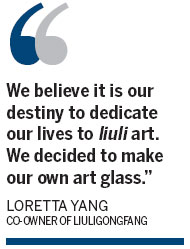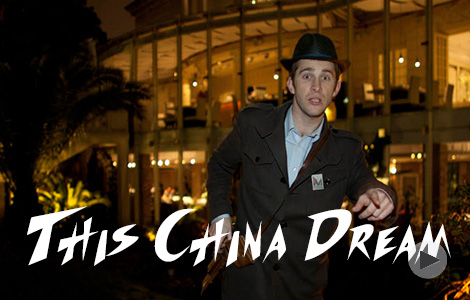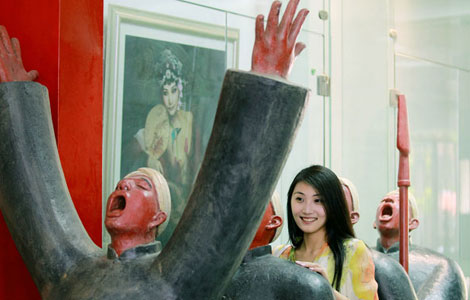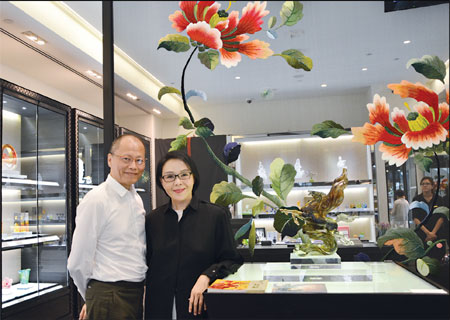Through a glass - brightly
Updated: 2013-09-30 11:05
By Liu Yiyi and Wang Jun (China Daily)
|
||||||||
|
Zhang Yi (left) and Loretta Yang stand beside their most recent liuli work "Victory from the Start" from the Year of the Horse collection in Liuligonfang's gallery in Brea, California. Liu Yiyi / for China Daily |
It's a shame that so many great techniques disappeared: Zhang
Loretta Yang seems destined to work in hot temperatures.
For 12 years, the two-time Taiwan Golden Horse Award best actress winner roasted under mercury vapor lamps to finish 124 films. And now, since 1987, she has worked next to high-temperature fires to fashion the molds for her liuli Chinese crystal, or art glass.
With her husband, renowned film director Zhang Yi, Yang quit the film industry and established Liuligongfang (meaning "Liuli art studio") in 1987.
In their last film together, This Love of Mine, Zhang decorated sets with a lot of art glass pieces to evoke the splendid, yet fragile life of the character, Yang recalled. "I was totally amazed by them," Yang said.
"We believe it is our destiny to dedicate our lives to Liuli art. We decided to make our own art glass," said Yang.
The couple sees it as a natural career path. "Film is creating something from nothing. You start from nothing to cast each and every different role," Yang said. "You have to taste, experience, imagine the new roles and you have to learn to challenge yourself, change from different situations, and adapt to new ones. This is exactly what I'm doing as a liuli artist."
"My experience in the film industry made me able to work in an unstable and frustrating atmosphere," said Zhang. "I too became extremely adaptable. These are very important qualities in establishing our Liuli art career."
Yang said, "We started late, so we had to work extremely hard. Our work hours were very long."
In the early 90s, Liuligongfang exhibited in Japan and was using a 150-year-old French technique pte-de-verre. A Japanese artist told Zhang that the Chinese had been using pte-de-verre since the Han Dynasty (BC 202-220 AD), but very few people knew it.
Zhang said, "It is a shame that so many great techniques disappeared from Chinese culture." Zhang defined culture as "attitude, core value, and belief," and said "a people will lose its identify if they don't see the value of their culture".

Yang sees what she has been doing for 26 years as retelling Chinese stories through a new medium - liuli. "I wanted to get people's attention by retelling Chinese stories through this beautiful texture liuli and make people focus again on the beauty of the emotion and the culture of our Chinese ancestors," said Yang.
Each piece - from the largest statue to the smallest pendant - from Liuligongfang has a story behind it. Zhang writes the description in graceful calligraphy. He believes people will understand Chinese culture better through Yang's art and his description.
Liuligongfang came to the United States in 1998. "We had few resources, but big dreams," said Yang. Liuligongfang's dream is to introduce Chinese culture on the world stage. "We know it will take time and there will be difficulties. But if you believe it, you can see it."
Liuligongfang has partnered with Gumps, a luxury gift shop in San Francisco, and now plan to enter South Coast Plaza, the largest high-end shopping center on the west coast.
"We know there will be setbacks," said Zhang. "But this is the road we have chosen."
Liuligongfang has two different product lines. "Branding products" to support the creation of the second, the "artist collection", which in turn leads to the development of branding products. No matter, the focus of all Liuligongfang works is the same - retelling the story of Chinese culture.
The Victoria & Albert Museum in the UK and the Corning Museum of Glass in New York are among the museums that have collected Liuligongfang's works, each of which is a limited edition.
"It takes time for Westerns to understand the Chinese culture," said Zhang. "It's hard for it to find the mainstream. But we're working on it."
(China Daily USA 09/30/2013 page2)

 Investing a nation's wealth wisely
Investing a nation's wealth wisely
 This China Dream
This China Dream
 Williams, Li into second round at China Open
Williams, Li into second round at China Open
 Visible face of CIC investment
Visible face of CIC investment
 Up, up, Huawei finds new friends in Europe nations
Up, up, Huawei finds new friends in Europe nations
 Yuxi to shield Fuxian Lake by creating wetland area
Yuxi to shield Fuxian Lake by creating wetland area
 A man with passion for China
A man with passion for China
 American batman soars through Chinese mountain
American batman soars through Chinese mountain
Most Viewed
Editor's Picks

|

|

|

|

|

|
Today's Top News
China calls on APEC to promote FTA integration
Japan, US kicks off 2nd round of TPP-related talks
Website launched to assist expat professionals
Shanghai opens free trade zone
50 foreign experts honored with Friendship Awards
Academic warns Obama on Pacific policy
US Confucius Institutes gather
NSA mapping networks of citizens
US Weekly

|

|








